Requested Item Level Process
After the request is approved at the request level, the process continues at the requested item level. The requested items within the approved request will undergo further processing and fulfillment based on the defined procedures and workflows.
Form
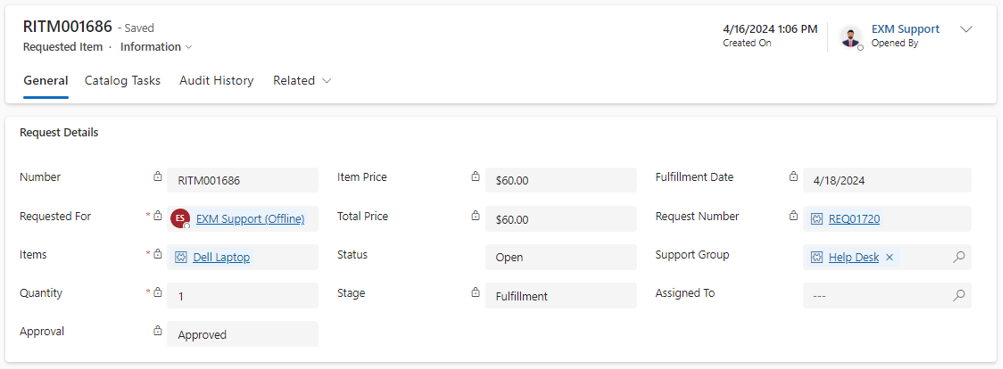
| Fields | Description |
|---|---|
| Number | Defines the Requested Item number. |
| Requested For | Defines the Requester name. |
| Items | Defines the Item name. |
| Quantity | Defines the quantity of item. |
| Item Price | Defines the item price. |
| Request Number | Defines the related Request number. |
| Stage | Defines the level at either the approval or task level. |
| Status | Defines the Status of Requested item. |
| Total Price | Defines the Total price for that item based on quantity. |
| Support Group | Defines the Support Group value for this Requested Item. |
| Assigned To | Defines the Assigned to person name. |
Item Workflow Configuration
The entire process for an item is defined in an "Item Workflow Configuration" entity. This entity outlines the specific workflow and steps involved in processing the item, including approvals, workflows and any other relevant tasks or activities. The item follows this predefined workflow configuration to ensure a consistent and streamlined process from start to finish.

| Fields | Description |
|---|---|
| Item | Defines the item name. |
| Type | Defines the type, whether we need Approval or a task. |
| Approval Type | Defines the Approval Type. |
| Order | Defines the order for a process. Process will take place in ascending order for an item. |
Within the "Item Workflow Configuration" entity, you have the flexibility to specify the desired process for a particular item. The "Type" field allows you to indicate whether an approval process or a task process is required for the item. This enables you to customize the workflow based on the specific needs and requirements of each item in the system.
a) When the "Type" Field has "Approval" value
Within the "Item Workflow Configuration" entity, you can define three types of approval for an item.
- Single Approver: In this type, the approval is assigned to a single person or individual.
- Multiple Approvers: This type allows for approval by multiple individuals or a group of designated approvers.
When choosing "Approval" as the type, you must specify the name of the person or persons responsible for the approval process. This ensures that the request is routed to the designated individual(s) for review and approval.

If you choose "Approval" as the type and select a group-based approval process, you must specify the name of the group. This ensures that the request is routed to the designated group for review and approval. The group name can be provided to identify the specific team or department responsible for the approval process.

if we choose approval as manager, then approval goes to requester's manager
b) When the "Type" Field has "Task" value
If you choose "Approval" as the type and specify "Manager," the approval process will be routed to the requester's manager. This ensures that the request is sent to the appropriate manager for review and approval. By selecting this option, the system will automatically identify and direct the approval request to the manager associated with the requester's position or hierarchy within the organization.
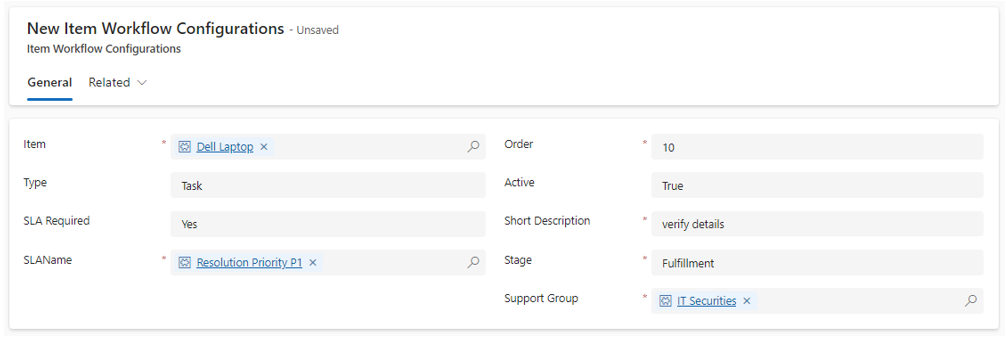
c) When the "Type" Field has "Workflow" value.
In the request module, when you choose the type as "workflow" the process involves selecting a specific workflow and then making a request for run based on the chosen workflow. Once the workflow type is selected, the system will prompt you to choose from a list of available workflows The workflow selection typically determines the steps and actions needed to fulfill the request successfully.

Use Cases of Requested Items
1.When all Requested Items are Complete then Request will be completed.
When all the requested items within a specific request have been successfully completed or fulfilled, the request itself is considered complete. Once all the requested items are marked as complete, the request as a whole achieves a completion status. At this point, the user is typically notified that their request has been successfully fulfilled.

Request :The completion of the request indicates that all the desired actions or items specified by the user have been successfully executed.

2.Request will be Complete, At least one RITM (Requested Item) is in Complete Status: There is at least one requested item (RITM) within the request that has reached the "Complete" status. This means that at least one of the items or actions specified in the request has been successfully fulfilled or executed. Request: Apart from the one RITM that is in the "Complete" status, any other remaining requested items (RITMs) within the request must either be in the "Complete" status as well or have been "Canceled" then Request will be complete.

3.Request will be "In Progress" when, At least one of the requested items is "In Progress"
When a user submits a request, it may contain multiple requested items, each representing a specific task, process, or workflow to be fulfilled. As these items are being processed, they go through various stages of completion, such as verification.
If any of the requested items is currently being actively worked on or is undergoing processing, it will have the status "In Progress". And Request will be "In Progress" as well.

Request: As long as one or more requested items are in progress, the entire request is considered "In Progress" It signifies that the request is still active and being worked on, and not all the requested items have been completed or marked as finished.

4.When all Requested items are On Hold then Request will be On Hold
When all the requested items within a specific request are placed in an "On Hold" status, the entire request is considered to be "On Hold" This status indicates that none of the requested items are currently being processed or fulfilled. In the following example there are two Requested items under the Request and Both are in "On Hold" status.

Request: When all the requested items share the "On Hold" status, it is a clear indication that the request cannot proceed until the specific issues or requirements causing the hold status are addressed.

Catalog Task
All tasks are created and managed within the "Catalog Tasks" entity. This entity serves as a centralized location for organizing and tracking various tasks related to catalog items. It allows users to create, assign, and monitor tasks associated with the catalog, ensuring efficient task management and seamless collaboration within the system.
The task catalog is a living document that requires regular updates. As tasks progress or get resolved, their status and relevant details are updated in the catalog. New tasks are added as they are received, ensuring the most current and accurate information is always available.
By maintaining a well-organized task catalog, organizations can streamline their request management process, improve collaboration among team members, and enhance overall efficiency in addressing and resolving various tasks and requests.
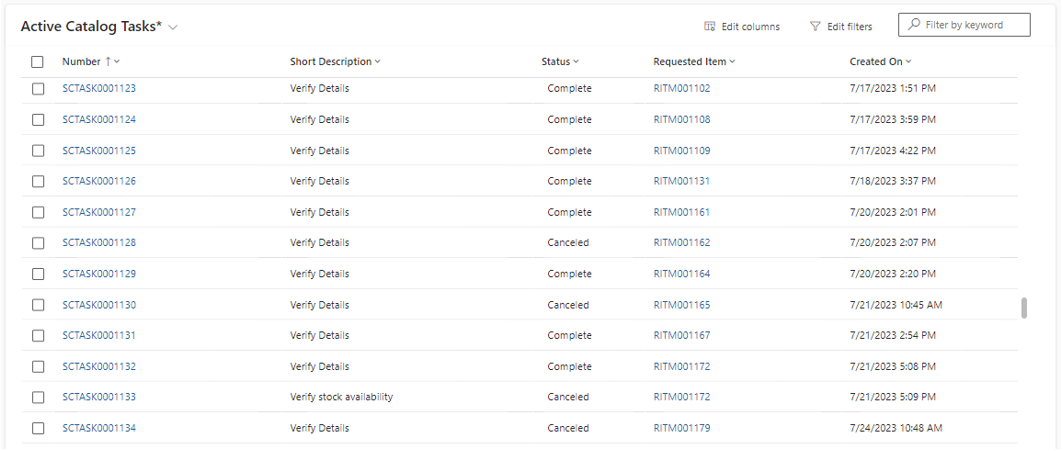
Form

| Fields | Description |
|---|---|
| Number | Defines the Task Number. |
| Support Group | Sets the name of the assigned support group for this task. |
| Assigned To | Sets the name of the person to whom this task is assigned. |
| Asset | Define the Asset for the Catalog Task |
| Requested For | Defines the requester's name. |
| Status | Defines the status of that task. |
| Requested item | Defines the related Requested Item number. |
| Type | The type of the catalog task (Fulfillment, Procurement) |
| Configuration Item | Defines the related Configuration Item |
| Priority | Defines the priority of the catalog task |
| Short Description | Brief about the catalog task |
| Description | Details about the catalog task |
An E-Mail and Microsoft Teams notification are sent to the designated support group to notify them that a task has been assigned to their team. The notification informs the support group that they are responsible for completing the task within the specified timeframe. This ensures clear communication and accountability within the support group, enabling them to promptly address and fulfill their assigned tasks.
Parallel Catalog Task
Within the request module, it is possible to concurrently generate tasks associated with catalog managements.
- To initiate the parallel task, you must initially include it in the "workflow configuration table" within the request module.

- After submitting the task through the portal, you'll observe that the parallel task has been generated and is now visible under the "catalog tasks" tab.
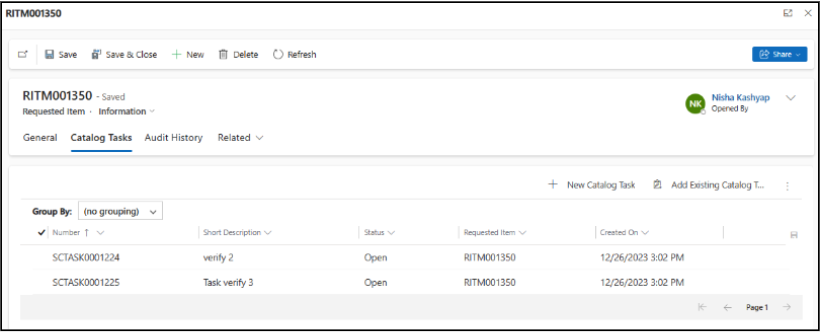
Use Cases of Catalog Task
1.When a Catalog task is In Progress then Requested Item will be In Progress Status
When a catalog task is marked as "In Progress" it signifies that the specific task associated with the requested item is currently being actively worked on or is in the process of being fulfilled. The status "In Progress" indicates that the task has not yet reached its final state, and there are ongoing actions or procedures being performed to complete it.

Requested items: As long as one or more catalog tasks are in the "In Progress" status, it implies that the associated requested items are also in progress.
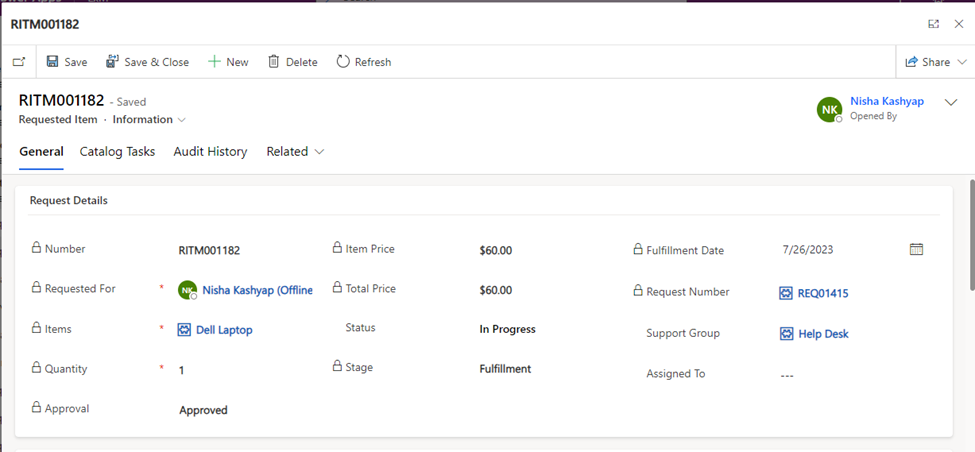
2. When all Catalog Tasks are Complete then Requested item will be completed
When all catalog tasks associated with a particular requested item are marked as "Complete," the requested item itself will be considered "Completed." Each requested item within a request is typically composed of one or more catalog tasks that need to be fulfilled to consider the requested item as completed

Requested Item: when all catalog tasks associated with a requested item are marked as "Complete," the requested item itself will be considered "Completed,". The completion status of a requested item indicates that all the necessary actions, products, or services associated with that item have been successfully delivered or executed
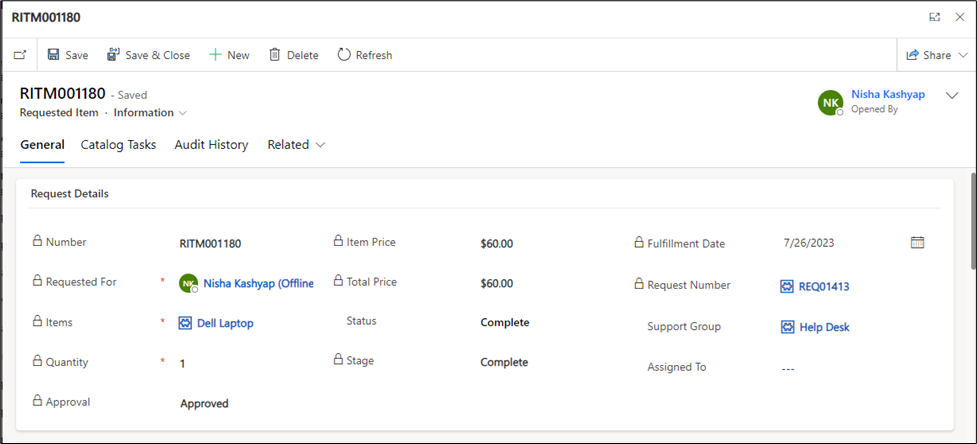
3.Requested item will be Complete, At least one catalog task Requested Item) is in Complete status
When at least one catalog task associated with a specific requested item is marked as "Complete," the entire requested item will be considered "Completed." Each requested item within a request typically consists of one or more catalog tasks representing different steps or actions needed to fulfill that item
4.When a catalog task is canceled then Requested Item will be canceled
When a catalog task is canceled, it leads to the cancellation of the corresponding requested item within the larger request. The status "Canceled" indicates that the specific task associated with the requested item will not be fulfilled or executed

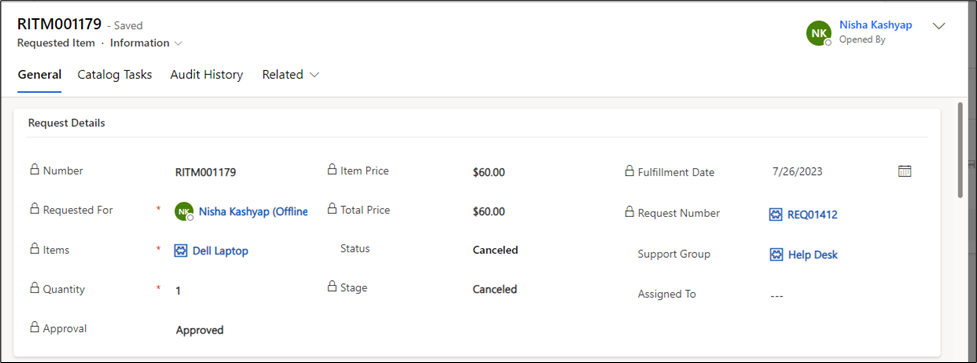
Request and Asset Integration
Assign the Asset for Catalog Task :When you click on the "Allocate Asset" button, a modal or pop-up window will appear. In this window, you'll be able to select the asset you want to use. This modal will only show you the assets that are available in stock for the item you're requesting. So, it helps you easily pick the right asset that's ready for use without any confusion.
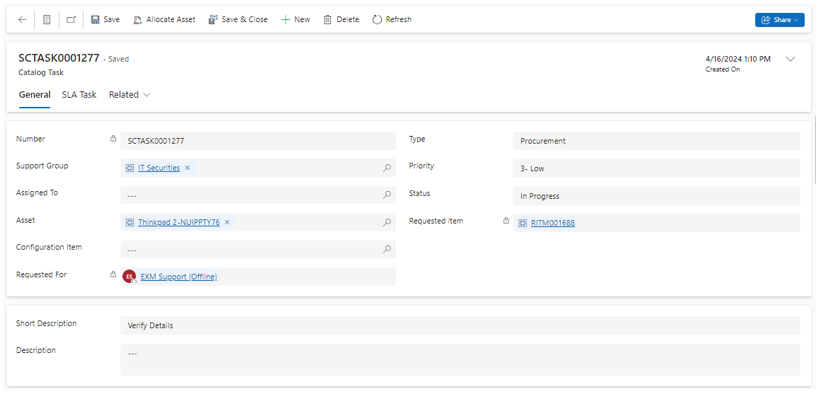
The "Allocate Asset" button will only be visible when you've selected "Procurement" as the type, and the requested item is not a consumable. |
Consume Asset for Catalog Task: when you click the "Consume Asset" button, it will display available assets in stock, and you can choose from the options, it will create a new record in the hardware asset table and assign that asset to the catalog task.
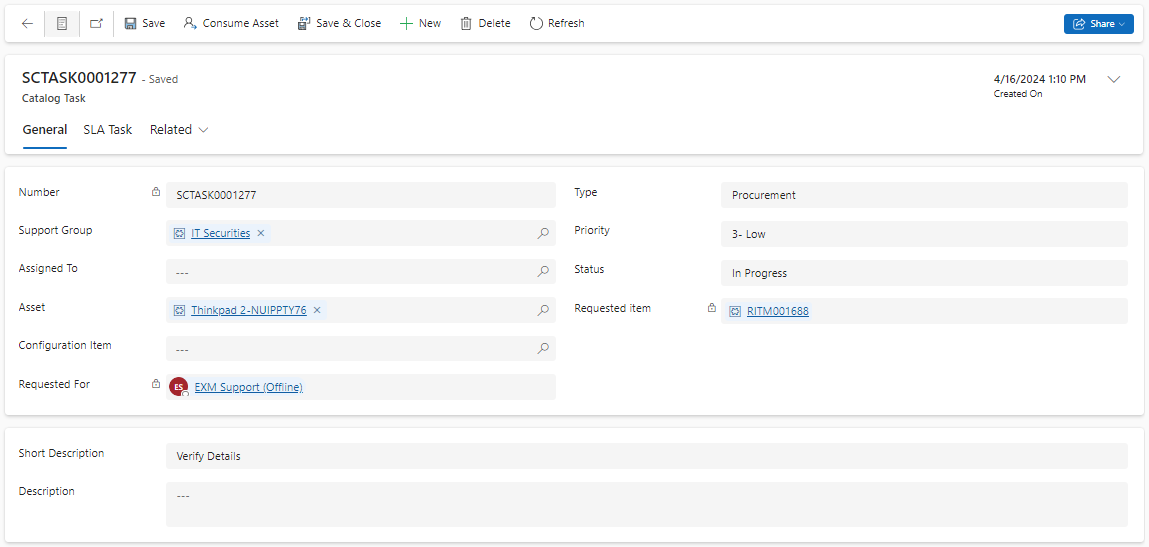
When you click on the "Consume" button, a modal will open up. In this modal, you'll be able to select the Assigned To, Select Asset and quantity of assets you want. After making your choices, you can click on the "Save" button. This modal makes it easy to specify the quantity and consume assets as needed.
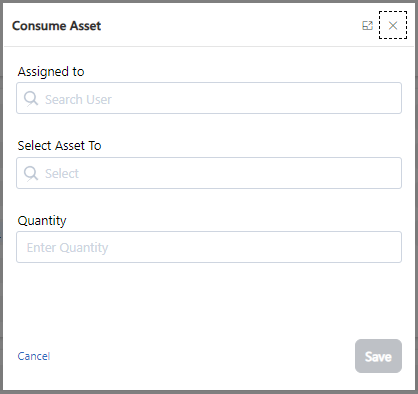
The "Consume Asset" button is only visible when you've selected "Procurement" as the type and the requested item is a consumable. |